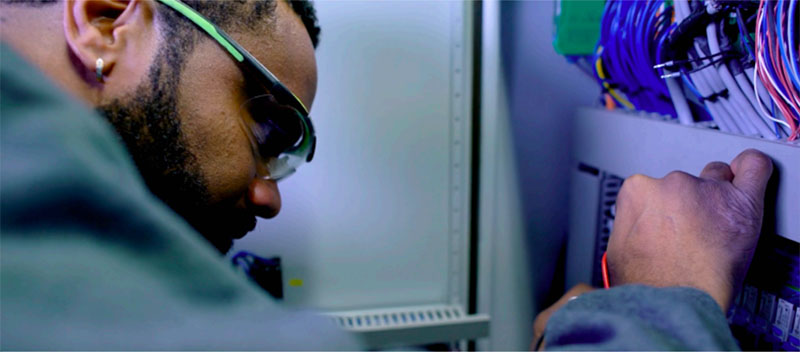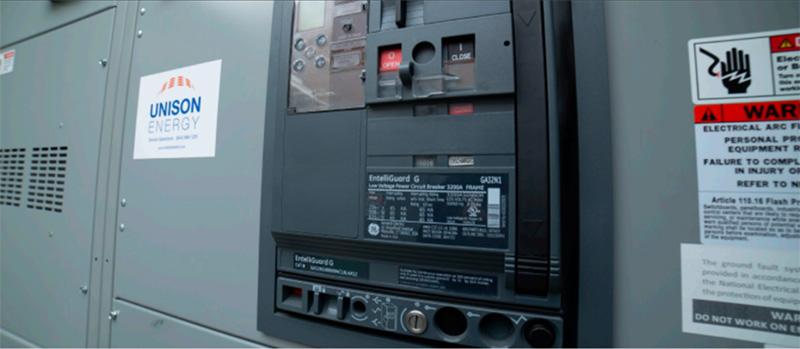How Island Mode Operations Work

During a grid outage, a microgrid will enter island mode through either a manual or automatic process in order to support the facility’s operations.
When an outage occurs on the electric grid — whether from a storm, a car hitting a power pole or a substation failure — businesses experience costly power disruptions. Industrial facilities can lose thousands of dollars per minute of downtime, as well as work in progress, while a supermarket might be forced to throw out millions of dollars in spoiled products.
To address this persistent risk, businesses turn to resilient on-site power in the form of microgrids. While microgrids typically operate in parallel with the grid, they are designed to enter “island mode” when the utility is down or not providing sufficiently stable power. When in island mode, microgrids provide on-site power generation that supports facility operations indefinitely, until utility service can be restored.
Although island mode is a simple concept, the details of the islanding process depend on how the site is configured to enter island mode. This process is governed by IEEE-1547, the Institute of Electrical and Electronics Engineers’ Standard for Interconnection and Interoperability of Distributed Energy Resources with Associated Electric Power Systems Interfaces. IEEE-1547 determines how distributed generation should respond in case of abnormal grid conditions or faults, such as the grid voltage or frequency falling outside of the normal range.
For most abnormal conditions, the generator must automatically disconnect and cease to energize from the grid. Where that disconnect occurs and what happens after is up to the microgrid design team, who can design a microgrid to enter island mode manually, automatically, or automatically with a seamless transition.
Manual Island Mode
Manual island mode is the simplest and least expensive method of providing resilient power to facilities that have lost grid power, as it adds few costs beyond the on-site generation system itself. This type of island mode is referred to as “manual” because it requires that an on-site operator is available to perform the following series of tasks:
- When the utility outage occurs, the generators shut down and disconnect from the local facility power distribution system automatically. If the facility has an emergency generation system, it will go through its typical startup and transition of emergency loads to the backup power source.
- The first step the operator must take is to disconnect the microgrid feed from the utility, accomplished through a physical key interlock that opens the utility main breakers so they can’t be closed, thereby preventing the system from accidentally reconnecting with the grid (or shocking the linemen fixing the grid).
- Next, the facility needs to shed loads from the facility’s microgrid by opening electrical circuit breakers or switches and setting automatic transfer switches to stay on the emergency power source. At this point, the microgrid can be activated, which can be as simple as turning a key to energize the facility’s busses.
- Next, the building’s loads are reconnected systematically, which involves closing each of the open breakers to restart critical services without overloading the microgrid generator.
- Coming out of island mode requires the on-site operator to go through a similar process, but in reverse, in order to reconnect the facility’s loads to the power grid.
Overall, this process could take just 30 minutes for a smaller facility, but depending on the size of the campus and available operating staff, it may take over an hour to shift all critical loads to island mode. Once island mode has been activated, the facility has to actively manage and prioritize its loads.
Microgrids employing manual island mode typically have less generation capacity than necessary to support the facility’s entire operating load, which helps maximize savings while still allowing the facility to support the baseload. The facility engineers can’t reconnect all loads but do have the flexibility to decide which loads take priority during the day, at night, and during different seasons. In the summertime, for instance, it might be most important that the microgrid supports the facility’s chiller plant.
Because of these inherent technical limitations, manual island mode is typically used for disaster recovery situations rather than business continuity and is a common choice for large, complex facilities, like hospitals, large hotels, and manufacturing companies. Certain types of facilities — including those with loads greater than one megawatt, those with multiple utility electric services, or those with a multi-building electrical load spread — are good candidates for manual island mode services, in part because the hands-on approach helps to avoid system overloading.
When in island mode, microgrids provide on-site power generation that supports facility operations indefinitely, until utility service can be restored.

Automatic Island Mode
Compared with manual island mode, automatic island mode is faster and more convenient. However, automatic island mode has some associated requirements. The facility needs electrically controlled circuit breakers, as well as the capability to automatically shed loads. In addition, for automatic island mode to work, the microgrid’s generation capacity must exceed the building’s loads and support not just baseload but peak loads as well. Automatic island mode typically ceases to energize the utility grid at the service entrance main breaker (point of common coupling) instead of at the generator as in manual island mode.
Another consideration is that manual island mode requires an on-site operator, which is more common at larger facilities with central plants. A smaller facility, like a supermarket, will likely not have a qualified operator to handle the load shed and load adds process. On a similar note, single-building sites are best suited for automatic transition island mode because they have relatively straightforward electrical distributions.
There are two forms of automatic island mode: seamless transition and open transition.
Seamless Transition
The seamless transition follows the same processes as manual island mode, but the actions are taken by a programmable logic controller that opens and closes the appropriate circuit breakers remotely. Load priority is set during the design process before the microgrid system is installed.
In many cases, those in a facility with seamless transition won’t even know that power’s been lost. The microgrid generator doesn’t shut down even as the facility disconnects from the grid. The disconnect happens upstream at the facility’s main breaker and takes a split-second to switch into island mode, thereby avoiding the need to shut down and reactivate the generator. However, if necessary, some of the loads — such as refrigeration and HVAC systems — may shut off for a few minutes as the shift happens. The logic controller stages how they are turned back on in order to prevent overloading the generator.
This process happens more quickly than manual island mode transitions. In some cases, the transition happens so quickly that the loads stay balanced and load shed is not required. If the facility has an emergency generator, it probably will not start since it never sees the outage. Transitioning out of automatic island mode also happens quickly. Typically, when the power grid comes back online and has been stable for a set period of time — typically about five minutes — the facility will transition back to grid parallel mode without an interruption in service.
Open Transition
The other form of automatic island mode is the open transition, which follows the same processes that occur in a seamless transition, with the key difference being that when the system detects that the power grid has gone down, the facility’s generator shuts off momentarily. The loads are shed after the main breaker to the site opens, at which point the generator turns back on and the logic controller adds the loads back in the sequence of priority. In this case, the store would experience a momentary loss of power. Any legally required emergency loads would be powered within 10 seconds, while the rest of the microgrid generators return to operation within approximately 30 seconds. The microgrid controller can be programmed to keep the emergency loads on the backup generator or allow them to transition to the microgrid generators.
Open transitions have become less common than seamless transitions, which are a more effective and efficient option. In some cases, the open transition is appropriate if the utility’s requirements or facility design prevents a seamless design. In addition, open transition provides a backup strategy should the seamless transition not function perfectly.
Island Mode Capabilities for Your Facility
Whether you’re interested in resilient power for disaster recovery or business continuity, Unison Energy can work closely with you to design and build the microgrid solution that is best suited to your facility’s needs. With load priority and generation capacity in mind, Unison can recommend the most appropriate island mode approach that will also maximize your savings.
While Unison Energy offers standard, proven microgrid solutions, the design team also assesses each facility’s existing infrastructure and provides custom solutions as needed, including electrical upgrades, HVAC integrations, and aesthetic coverings. During the design process for manual island mode, we also work closely with customers to develop, test, and practice transition procedures.
For every customer, our microgrid systems can run indefinitely off the grid, protecting your business from costly disruptions. We aren’t just installing engines — we’re creating energy systems that will provide energy resiliency for decades.
For more information on how island mode can help protect your facility from power outages, click here to contact Unison Energy.
Energy insights, delivered
Subscribe for more content.
